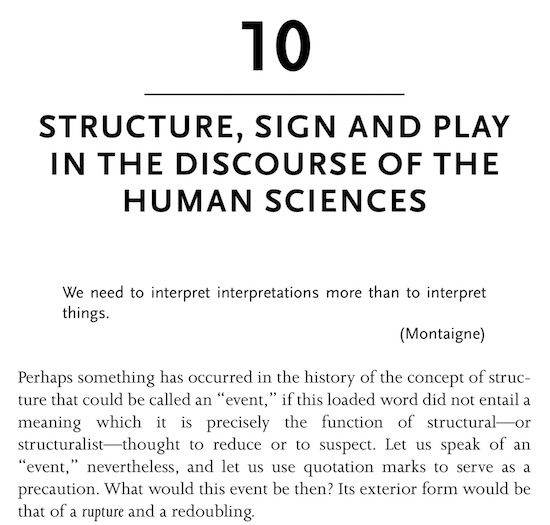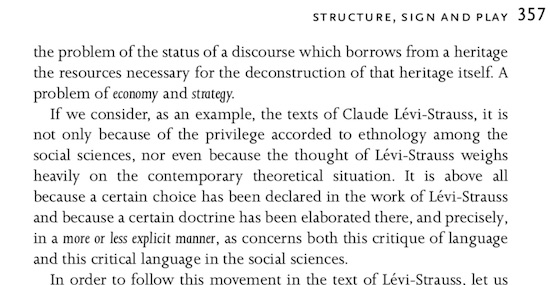
Now that I’ve briefly introduced postmodernism, I thought I’d go a bit deeper into Derrida’s method, if only because it’s constantly cited by people who seem to have never read his work. The details of deconstruction are laid out in a series of essays, which have been compiled in English as Writing and Difference. The entire book is available free on the internet here. What I am outlining here is Derrida’s most famous paper, entitled “Structure, Sign and Play in The Discourse of The Human Sciences.” This essay was originally penned in French, in the mid 1960s. It begins on page 351.
The work opens with a quote from Montaigne about hermeneutics, and that’s useful, because deconstruction can simultaneously claim to be a method or science of interpretation, and also the negation of the possibility of interpretation itself.

Derrida does two interesting things at the outset. In the first place, he immediately moves into an allusion to event ontology, which is meaningful. I first became familiar with event ontology by reading Alfred North Whitehead’s Process and Reality and Bertrand Russell’s Introduction to Logical Atomism. What philosophers and scientists mean by event ontology is the reduction of all metaphysical claims into temporal slices of reality. We don’t usually think of events as things, but at the basic level of the universe, there is a case to be made that events are the foundational atoms that construct everything we sense and experience.
The second interesting thing Derrida does at the outset is announce his attack on structuralists. By structuralists I mean guys like Claude Lévi-Strauss, and Michel Foucault. These were thinkers who were trying to get at the hidden meaning behind everyday reality, and as we’ll see in this essay, postmodernists hold that even if there is some hidden meaning behind our phenomenological filter, we are hopelessly incapable of divining it.
Derrida declares that there is no longer a central ontological repository through which human beings can interpret the world uniformly. What does this mean? As near as I can tell, he is looking back at a linguistic golden age, in which human beings learned a single word to describe a single state-of-affairs. If such a golden age existed, it doesn’t exist now. Sloterdijk’s recent work takes off on this quite well, and in some places he alludes to colonization as a factor. In a short period of time, Europeans started to be exposed to all sorts of strange, unimaginable objects: feathery Indian headdresses, digeridoos, Amazon parrots… The language couldn’t keep up, and people were confused not only about naming all these new things, but classifying them generally. Derrida doesn’t take the historical position Sloterdijk does, but he alludes to the loss of the concept of God as an ontological center, and in doing so, he’s touching on the same process. God was once the ultimate underwriter of all systems of interpretation, but God has quit that job, at this point. After God, the modernists abstracted away theology and fixed meaning with Cartesian ideas like objectivity and deductive logic. That passed away too. The signifiers and signifieds became, in that event, no longer fixed. Signifiers are free, to some extent, to point toward an infinitude of meanings.
The absence of fixed meaning allows for the analysis of a fault-line within the text. What Derrida wants to analyze, beginning on 357, is Lévi-Strauss’ work The Raw and The Cooked, which is one of the greatest works on structuralism.

The posit of a difference between nature and culture is, for Lévi-Strauss, evidence of a structural fault-line, and Derrida proceeds to analyze the incest taboo within that text to see exactly what the differentiation might be. “There is no scandal,” writes Derrida, “except within a system of concepts which accredits the difference between nature and culture. By commencing his work with the factum of the incest prohibition, Lévi-Strauss thus places himself at the point at which this difference, which has always been assumed to be self-evident, finds itself erased or questioned” (358).
With this example, Derrida sets up a methodology which will soon be generalized and used on all manner of discursive events –and not strictly texts– including sculpture, mathematical proofs, and
Finally, Derrida criticizes Lévi-Strauss as remaining “faithful to this double intention: to preserve as an instrument something whose truth-value he criticizes” (359). One might apply this to deconstructionism itself, which preserves the text as an instrument even as the deconstructionist attempts to prove it undefinable in the process.
” God was once the ultimate underwriter of all systems of interpretation, but God has quit that job, at this point. After God, the modernists abstracted away theology and fixed meaning with Cartesian ideas like objectivity and deductive logic.”
This seems to be the crux of postmodernism. It isn’t an attempt to understand truth; it’s a bomb shelter for escaping truth when it becomes dangerous to the ego. I would sum it thus: “If science ever proves the existence of God then we should replace science with ignorance.”